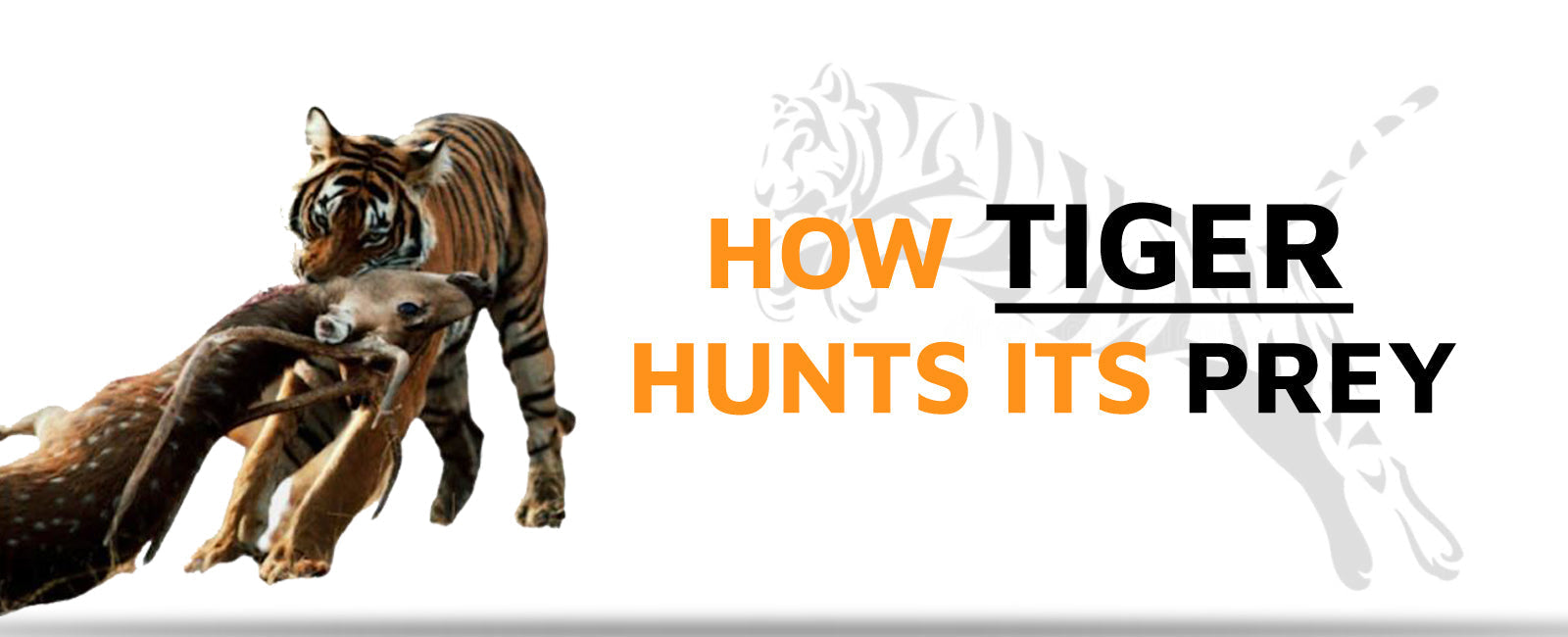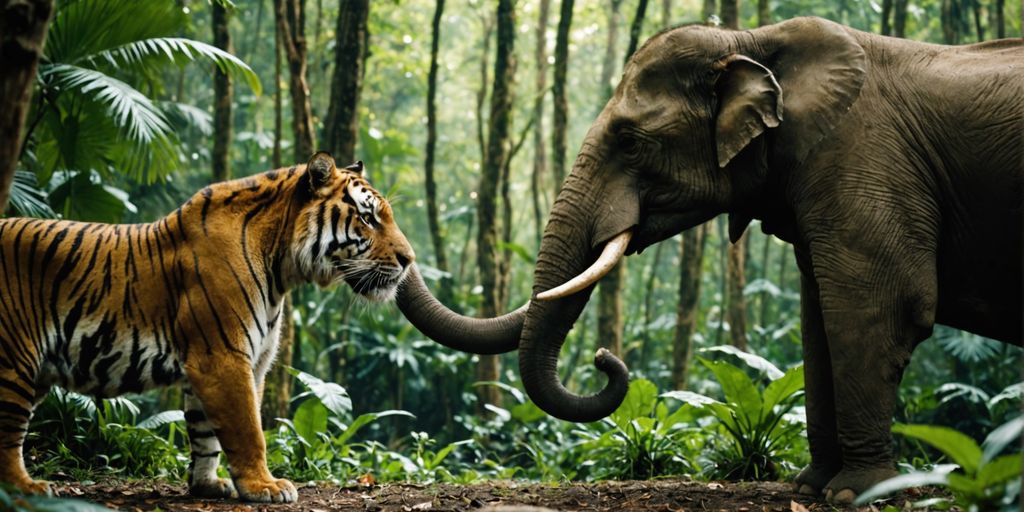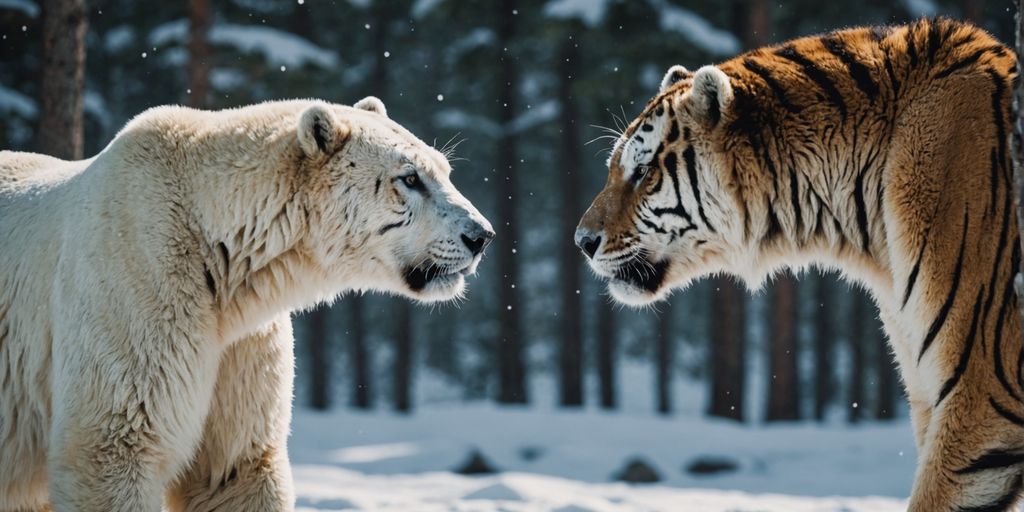Your Cart is Empty
🙏HELP US SAVE TIGERS!🐅 WE DONATE 1% OF OUR SALES TO WILDLIFE ORGANIZATIONS ( WWF ...)
Menu

🙏HELP US SAVE TIGERS!🐅 WE DONATE 1% OF OUR SALES TO WILDLIFE ORGANIZATIONS ( WWF ...)
How Tiger Hunts its Prey?
May 28, 2021 11 min read

If anything makes the Tiger a unique animal, it can hunt efficiently. Everyone knows the super-powerful strength, as well as the cunning that this predator can display. But do you know how it tracks?
The most potent animals all have a very different way of hunting. And while it may seem like an easy thing to do given their abilities, the reality is far less apparent. The tracking of the game is a complex science, which only a few species such as the Tiger have mastered completely!
At the end of this article, you will know :
- The stages of Tiger hunting
- The subtleties that make the Big Cat a super predator
- The typical course of its day
Finally, after reading this article, you will know if the Striped Fawn is indeed the most dangerous and fearsome hunter living on our planet!
Let's stop beating about the bush and get straight to the heart of the matter: the Tiger and the Hunt!
The stages of the hunt
1) The search for its future prey

Unfortunately for the tiger, its future prey does not come to throw themselves into its mouth, but on the contrary, they flee it like the plague. The tiger has to go on long or short walks searching for an animal to his liking to feeding.
His stalking of the game is organized because he watches the various water points he knows in priority. The herbivores living in its territory will sooner or later be forced to go there to quench their thirst.
Once the tiger spots its next meal, the second step can take shape!
2) The silent approach

Contrary to what one might think, the Tiger is not an excellent runner. Although it can reach speeds of 60 km/h, it cannot maintain this speed over long distances. This lack of stamina forces it to adopt a particular strategy: the silent approach!
The feline approaches its prey slowly but surely, thanks to its tiger coat but also its paw pads. Its ability to be a formidable hunter depends mainly on its power of concealment within the environment that surrounds it.
If once he is close enough, he still hasn't been spotted, then he can finally engage the 3rd step and go on the attack!
3) A fast and devastating leap

As soon as it gets close enough to its prey, the Tiger pounces on it when it is most vulnerable. The poor beast sees more than 200 kilos of muscles and nerves fall on it, so its chances of survival are slim.
Moreover, the Tiger will always aim at the neck or the nape of the neck to leave it no chance. It takes him only a few seconds to kill his victim, but sometimes several hours to find and approach him. As we told you before, the big cat lacks stamina in combat, explaining why its attacks are so lightning fast.
But as the saying goes, after the effort comes to the comfort!
4) The ultimate reward

Here is finally the reward so much awaited by the Tiger; the latter is now facing the carcass of his prey. But there is no question of him eating it on the spot; he takes the animal's body to a safe place so that he can enjoy it in peace.
The interesting thing to know, even when he eats, the Tiger stays on the lookout for the slightest sound. That's why it avoids making noise when it chews or drinks.
To believe that the Tiger is a pig would be a mistake because it is not uncommon for it to consume its meal over several days in addition to eating quietly. It can ingest up to 30kg of meat in one go, so a catch weighing 100kg will be consumed in 2-3 days. To do this, he will hide it as he can under foliage sheltered from the sun.
On the other hand, this hunting method is far from being infallible, and this is what we are going to see right now!
The limits of this hunting method

If you have followed the previous section carefully, you may think that the Tiger rarely fails in the hunt. Well, think again, because only one attack out of 10 is successful. There are two main reasons for the repeated failures of the striped fawn.
First of all, animals living in trees and birds are a real handicap for the Tiger. Why would you tell us?
Well, they constantly betray its position by shouting alerts. It becomes very complicated for him not to be spotted by herbivores and animals in height, especially as he struggles to see them. It seems that the whole jungle is allied against the Tiger to limit its insane strength.
But this is not the only reason for its low success rate.
The 2nd defect of the big cat is, of course, the fact that it gets exhausted very quickly. Therefore, even if it has managed to approach its prey without being spotted, it is not 100% sure to come to an end. If he can't bite it in the neck, it will take a lot of energy to kill it. So, even if they have fallen into the clutches of the Tiger, the herbivores still have a chance to survive.
Hunting is not that easy for this predator. But fortunately for him, he is endowed with qualities allowing him to compensate for these two disadvantages!
The particularities of hunting the striped fawn
1) The Tiger: a Night Hunter

Of all the elements that make the Tiger a unique hunter, night stalking is undoubtedly one of the most important. Unlike the Lion, which will always prefer to attack in daylight, the Striped Cat is much more at ease in the dark. The darkness of the night allows him to sneak through the foliage with even more skill.
This particularity explains why so few pictures of Tiger hunting exist on the net. However, although it prefers to hunt at night, if a prey presents itself on its way, it will not hesitate to attack it in broad daylight.
We can see that the latter has become a real night hunter for efficiency because it is much more complicated for the animals to spot the Tiger with only the white glow of the moon as a source of light. On the other hand, the feline has perfect night vision thanks to its retina, which needs a weak light source to give it a clear and precise view!
Moreover, we offer you the possibility to admire the Tiger up close with this exotic painting!
2) A predator from a young age

In your opinion, what is the best way to become a reference in your field? Training, of course!
Since his youngest age, the Tiger is conditioned to become an outstanding predator. If there is one person who is at the origin of this superiority, it is, of course, his mother. She starts teaching him all his hunting skills at the age of 1. She will continue to teach him until he reaches the age of 3, after which he will leave the family home.
But how does she pass on her knowledge to him?
First of all, she instilled in him a taste for fresh meat only a few months after his birth. To do this, she gradually makes him lick, chew, then eat the flesh of animals she has hunted beforehand.
Once the cub reaches about a year old, it follows its mother to hunt for a game. At this time, he will develop his hunting skills, as nothing is more rewarding than experience in the field. Once he feels ready, he will begin to hunt gigantic and larger prey on his own until he reaches the giant deer.
When not hunting, the Tiger spends his time fighting with his brothers and mother to test his strength. Fights between these little Tigers are often friendly, and even if things get out of hand, the Tigress will always be there to bring order.
After learning about why the Tiger is a fearsome and fearedpredator, it's time to see how her typical day is organized!
The Big Cat's typical day

The Tiger's day is similar to that of cats, which means that it is interspersed with naps!
The Tiger wakes up from one of his morning naps to see what's going on in his territory. He surveys the boundaries of his habitat, looking for any sign or scent that another Tiger has intruded. Knowing that the range of this animal can extend up to 150 km², you can imagine that he can't go around in only one time.
This animal will wander in its territory throughout the day while resting regularly on grass. He will also take the opportunity to go to the water sources he knows to refresh himself. If the hunger is felt and a poor animal presents itself to him, he will kill it. However, at this time of the day, his priority is not to feed but rather to resist the sun's oppressive heat by hydrating himself.
The afternoon follows the same rhythm as the morning, although the naps are much longer and more critical. The Tiger prefers to progress on his lands when the sun is not at its zenith to get too tired!
Once the night falls, it is a very different facet of his personality which sees the day. The giant beast goes into hunting mode, and his only goal is to find prey big enough to fill his appetite. Once his victim is caught and killed, he will eat it gradually over several days.
In this way, the Tiger will roam around the dead animal's carcass to protect it from scavengers and birds. It will not hunt for a few days while it finishes its meal, but the cycle will resume once the meal is completed.
The daily life of the striped feline is thus marked by an exact rhythm that he tries to respect.
The Tiger's diet
1) A carnivore at heart

Tiger is a carnivore animal, which means it feeds solely on meat. There is no question for such a predator to eat plants!
Its digestive system is flexible enough to accommodate any meat, from small rodents to larger mammals. This is rarer, but some observers report that it would even feed on freshwater fish.
However, the Tiger's diet can vary between species because the animals that share the habitat of the Siberian Tiger are not the same as those living on the lands of its Bengal cousin.
When it comes to feeding, the big cat is not complicated and takes what it finds on the spot. Therefore, its geographical environment will more or less determine its diet!
2) The Tiger's favorite prey

Even if the Tiger can eat all types of animals, some prefer others. This is the case for deer such as the chital or the sambar. These animals can be recognized by the characteristic presence of antlers on their heads.
If the Tiger likes them so much, they live in herds and therefore offer a wide choice of prey. In addition to that, these animals are mostly very nutritious and "relatively" easy to hunt.
In addition to deer, he also loves to hunt wild boar. These large pigs are equipped with tusks and are found in the woods and forests of India. Their weight can reach 250 kilos, which is as much as that of the big Tiger. It is, therefore, more difficult for the latter to defeat them, but the reward is even greater if he succeeds!
In the end, the favorite preys of the Tiger in its natural environment are :
- deer
- wild boars
- elk
- buffalos
It is important to note that the massive deforestation in Asia has dramatically disrupted the eating habits of the Tiger. As a result, the Tiger is more and more forced to attack livestock to survive.
You have the opportunity to actively defend the Tiger's environment with our latest Military Belt, don't miss this chance!
Is the Tiger the most fearsome land animal?
1) More than impressive skills
To know if the Tiger is the most dangerous land mammal, it is essential to summarize its abilities!
To begin with, the Tiger is very skillful in the water, which makes it the best swimmer among the felid family. It can make sea attacks surprise their prey (even if it is rare). The Tiger can also swim up to 15km from the coast, allowing it to change the environment and discover new catches!
Moreover, the big cat is equipped with sharp claws, pointed canines, and a powerful jaw. This allows him to hold on to his victims and never let go. Its feet are razor-sharp, and its bite is one of the most powerful in the animal kingdom.
Finally, its ability to become completely invisible in its environment is quite impressive. As the old saying goes: "If you see the Tiger once, it has already seen you more than 1000 times". Its camouflage and its talent for discretion allow it to be forgotten entirely. Contrary to what people think, its orange color is a real advantage because it imitates perfectly the sun's rays going through the vegetation.
You would have to be completely crazy to say that the Tiger does not have the weapons of a super predator. However, the competition is tough because other animals are also at the top of the food chain!
2) Other animals compete with it

Among all the terrestrial predators that inhabit our beautiful planet is an elite group of the most powerful animals. These species are not numerous, but they reign supreme over the wildlife. They do not fear any other beast (except humans) because they are at the top of their food chain.
Now that we have titillated your attention, you surely want to know who are these ultimate hunters. In this little family, we find :
- The Tiger
- The Lion
- The Polar Bear
- The Wolf
As you can see, the dominance of the Tiger is questioned next to such big wild animals. Even if the Lion and the Wolf have no chance against the Tiger in 1 on 1, they have all their strength from the pack they live in. It becomes tough to know which species dominate the other.
The Polar Bear is a solitary animal as well as the big cat. However, the environment of these two predators is opposed, with on one side the icy cold of the North Pole and on the other the oppressive heat of the Indian savannah. Once again, these differences make the comparison hazardous and misleading.
From a scientific point of view, it is useless to know which is the ultimate super-predator because it depends on geographical and social factors. Each of the four species mentioned above reign without any opposition in their environment.
The fact that these animals do not live together on the same territory prevents us from determining the most fearsome terrestrial predator!
To summarize
To summarize all that has been said, we could say that the Tiger is an extraordinary hunter both by his physique and by his killing abilities. But to do that would be to hide the fundamental elements that make him a unique predator!
First of all, the stages of his game hunting are simply brilliant. We understand that the Tiger hunts in an orderly way, almost protocol. Nothing is left to chance for this big cat from the search for prey to the deadly attack.
But it wouldn't be so easy for him if he wasn't naturally endowed with hunting skills. Thanks to his perfect night vision and agility, he perfectly takes advantage of the night to get closer to his future victims without being noticed. This power of discretion is taught to him from a very young age by his mother. The Tiger takes advantage of its natural abilities, such as its camouflage, to constantly improve its stealthy attacks.
The Tiger is, therefore, a formidable predator, but for whom?
We have seen that it has a weakness for herbivores and, in particular, for deer. As it is a carnivore, it feeds exclusively on meat. However, this does not prevent it from having a very flexible diet. So beware if you venture onto the Tiger's land because you could very well become its next meal!
Finally, other animals compete directly with the Tiger for the position of ultimate super-predator. Among them is the Polar Bear, with its vast size and ability to withstand extreme conditions. But also the Lion and the Wolf, which both get their strength from hunting in packs. These four species are the most gifted land mammals for hunting.
Unfortunately, we will disappoint you because it is impossible to say whether the Tiger is superior to the other predators. These four animals live in different geographical areas means that they never compete.
So, even though it may not be number one, the Tiger is still a born killer!
Before you go, don't miss the opportunity to please your child and teach him or her everything you know with this Tiger Hunting Figure!
Also in Tiger Blog

Sloth Bear vs Tiger: Who Would Win?
July 13, 2024 7 min read
Explore the thrilling showdown between a sloth bear and a tiger, analyzing their strengths, behaviors, and survival tactics.
Read More
Tiger vs Elephant: Who Reigns Supreme in the Animal Kingdom?
July 13, 2024 7 min read
Explore why elephants usually triumph over tigers in the wild, highlighting their size, strength, and defensive prowess.
Read More
Epic Battle: Polar Bear vs Tiger, who win?
July 11, 2024 8 min read
Epic showdown: Polar Bear vs Tiger. Discover who would win in this thrilling battle of nature's fiercest predators.
Read More

